Description
Customer Service training in Email Communication.
Quick, courteous communication via email can boost productivity and enhance customer relationships, while careless and unprofessional email can frustrate and antagonize customers, coworkers, and others.
Your package includes 10 copies of the Training Booklet plus downloadable Leader’s Guide, Quizzes, and Certificates.
The Training Booklets may be used on their own for self-study or you may conduct more formal training sessions with the Leader’s Guide and Certificates.
Training Booklet
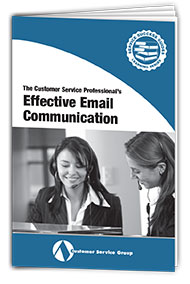 Our unique approach shows readers how to transfer their customer service skills and techniques to written text. It’s a practical approach that reinforces basic service skills and teaches email writing skills at the same time.
Our unique approach shows readers how to transfer their customer service skills and techniques to written text. It’s a practical approach that reinforces basic service skills and teaches email writing skills at the same time.
Readers will find techniques, sample text, and examples that they can incorporate into their own email right away.
Read the table of contents and sample below to see how much useful information is packed into this brief Guide.
TABLE OF CONTENTS
- Make a positive impression
- Slow down and read between the lines
- Determine whether email is the best way to respond
- Use a professional greeting and closing
- Keep it brief
- Set the right tone
- Make your message clear
- Keep language differences in mind
- Use formatting to make your message easier to read
- Use header options wisely
- Check your work
- Create email templates to answer frequently asked questions
- Don’t let your emotions take control
- Reply in a timely manner
- Understand that delivery is not guaranteed
- Email review checklist
SAMPLE
Slow down and read between the lines
Just as you listen carefully when speaking to customers, you must give that same level of focus and attention to customer emails if you want to handle them correctly.
This involves reading carefully to determine the reason for the message as well as “reading between the lines” to determine unspoken or related needs.
The goal, of course, is to make your response as complete as possible so that you do not create a frustrating chain of email with the customer.
A good example of reading between the lines and answering unstated needs is seen in the following example.
A customer writes to ask if rain coats are available in plus sizes. Rather than a simple “yes,” a more complete answer alerts the customer to the limited range of colors available in plus sizes and directs the customer to the size chart on the company website.
Getting good at finding a customer’s spoken and unspoken needs is hard. In a conversation, you can ask questions to draw out the information you need. But in an email, you can only work with what the customer has written. Fortunately, you can read between the lines to provide complete information.
Leader's Guide
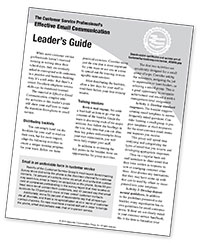
To help you get the most from your training materials, you’ll receive a copy of the Leader’s Guide. It will show you how to introduce the materials to your staff in a positive and motivating way. How to reinforce important points in the Student’s Guide. Plus techniques to keep the message fresh long after the materials have been distributed.
Best of all, you don’t have to be a professional trainer. The Leader’s Guide includes discussion topics, activities, trainer’s tips, and more.
Read the sample below to see how much useful information is packed into a brief section of this Leader’s Guide.
SAMPLE
Activity 2: Empathizing and agreeing
A skill related to apologizing is empathizing and agreeing. As noted in the Student’s Guide, this is one of the most powerful ways to calm an angry customer, but it can also be a difficult skill to master. For this activity, you can use the sample “problems” you created for Activity 1, or develop new problems. Write these on a white board or poster board. Next, ask your team to brainstorm strategies for showing empathy and agreement. Introduce the activity with language such as: “It’s difficult to continue to argue or be upset with someone who understands and agrees with you. If you’ve ever been in this situation, you know how quick and effective it is, so let’s brainstorm how we can show empathy and agreement with each of these statements, all without disparaging the company or a colleague.”
Also keep in mind that apologizing, empathizing, and agreeing can often be wrapped into the same sentence. For example, “I’m so sorry, I had a similar situation myself, and we certainly could have handled this better.” That’s a lot of good stuff in one sentence!
Certificate
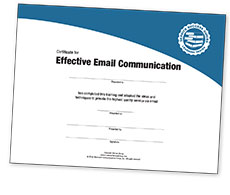
Use these certificates to acknowledge significant learning and development, and to provide motivation to put new skills into action.
Certificates may be downloaded, personalized, and printed.
Quiz
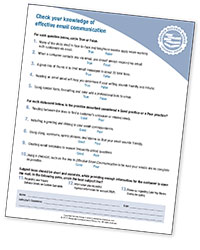
A brief quiz is included to ensure that students have retained the most important information and are ready to put it into action.
Quizzes may be downloaded and printed.
Guarantee
Your purchase is guaranteed. If you are not 100% satisfied, please notify us within 15 days of receipt for a full refund.
About the Publisher
The Customer Service Group provides ready-to-use tools for customer service training and frontline motivation including a monthly newsletter, training packages, and Customer Service Week celebration materials.

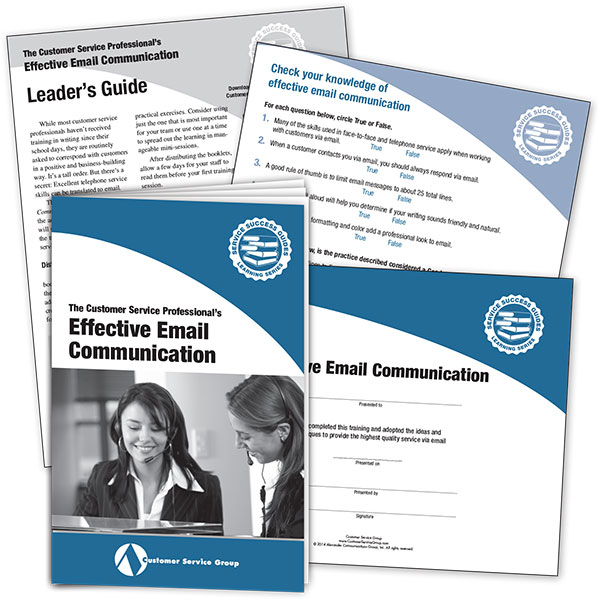
 Our unique approach shows readers how to transfer their customer service skills and techniques to written text. It’s a practical approach that reinforces basic service skills and teaches email writing skills at the same time.
Our unique approach shows readers how to transfer their customer service skills and techniques to written text. It’s a practical approach that reinforces basic service skills and teaches email writing skills at the same time.

